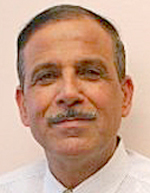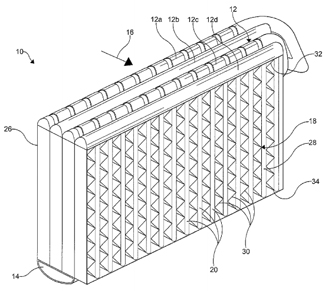 The Phase Change Matters e-mail newsletter is a weekly summary of the latest news and research on phase change materials and thermal energy storage. To subscribe, visit www.puretemp.com/subscribe. For more frequent updates, follow @puretemp on Twitter or visit the Phase Change Matters blog, www.puretemp.com/pcmatters.
The Phase Change Matters e-mail newsletter is a weekly summary of the latest news and research on phase change materials and thermal energy storage. To subscribe, visit www.puretemp.com/subscribe. For more frequent updates, follow @puretemp on Twitter or visit the Phase Change Matters blog, www.puretemp.com/pcmatters.
CONSTRUCTION
PCM building materials cut energy costs significantly in New Zealand study
In an interview with the New Zealand Herald, Dr. Mohammed Farid of the University of Auckland discusses new research on the impact of phase change material in building materials.
 “The benefits of applying PCM in buildings is not limited to capturing day solar heat in winter and night coolness in summer but also to create peak load shifting,” said Farid, a member of Entropy Solutions‘ advisory team. “When you have PCM in the walls of your homes you could switch [off] your heating or air-conditioning for extended period without having the indoor changing significantly.”
“The benefits of applying PCM in buildings is not limited to capturing day solar heat in winter and night coolness in summer but also to create peak load shifting,” said Farid, a member of Entropy Solutions‘ advisory team. “When you have PCM in the walls of your homes you could switch [off] your heating or air-conditioning for extended period without having the indoor changing significantly.”
Farid’s research article, “Peak load shifting with energy storage and price-based control system,” concludes that PCM-infused building materials could cut home energy costs significantly. The research was published last week in the journal Energy.
“Experimental results showed that using thermal storage material in conjunction with the proposed price-based control method can improve performance of these systems and lead to a successful peak load shifting,” according the article’s abstract. Based on New Zealand electricity rates, savings of up to 62.64 percent per day were achieved for the building applications.
But the cost of such materials remains a barrier.
“The cost of PCM needs to be reduced,” Farid told the Herald. “And it must be used wisely to make it economical.”
CONFERENCES
N.Y. conference on renewable energy set for Sept. 24-25
Registration is open for the REV4NY conference and expo in New York City Sept. 24-25.
“Reforming the Energy Vision” – REV – is New York State’s effort to pave the way for utilities, homeowners and businesses to adopt renewable energy technology more easily.
The conference agenda and list of speakers are still in flux, but Day 1 includes a session on integrating behind-the-meter storage with solar, EV and other technologies. Networking sessions and opportunities to explore partnerships are also on the agenda.
ENERGY STORAGE
Ice storage has price advantage over grid-based batteries, MacCracken says
CALMAC CEO Mark MacCracken tells the Washington Examiner that his company’s ice-based energy storage system has an advantage over its big-battery counterparts. Tesla‘s new grid-based batteries are priced at $300-$400 per kilowatt hour, he says, while CALMAC’s IceBank is priced at $100 per kilowatt hour.
The IceBank concept is simple: Make ice overnight, when the cost of electricity is lower, and use it to cool buildings during the day.
“Like the IceBank, batteries can soak up electricity to offset power demand, but they do it at nearly nine times the cost, according to a recent CALMAC study. It says six batteries are required to equal the same storage capacity as one IceBank,” the Examiner reports.
RENEWABLES
‘Green banks’ offer low-interest loans for renewable-energy projects
A new report by the Union of Concerned Scientists cites state-led loan programs as “a promising avenue for scaling up investments in renewable energy and energy efficiency that can reap significant economic and consumer benefits.” The report cites six initiatives in the United States:
Connecticut’s Green Bank: “Over the past three years, the program has completed 8,800 projects and installed solar panels in more than 10,000 Connecticut homes, thereby creating almost 6,200 jobs and reducing carbon emissions by one million tons.”
New York’s Green Bank: “In October 2014, New York announced its first round of Green Bank investments, totaling $800 million, across a diverse portfolio of investment types and clean energy market segments.”
Pennsylvania’s Keystone Home Energy Loan Program (HELP) and Warehouse for Energy Efficiency Loans (WHEEL): “Since its inception, Keystone HELP has supported more than 12,000 residential loans totaling nearly $90 million.”
Kentucky’s Home Performance Program: “The program supported 1,000 retrofits of single-family homes and trained some 150 contractors to perform energy efficiency retrofits in the state.”
Iowa’s IADG Energy Bank Revolving Loan Program: Offers $50,000 to $300,000 in the form of 1 percent interest loans for up to 10 years.
Massachusetts’ Mass Save HEAT Loan: “Energy efficiency experts consider the HEAT Loan program one of the most successful U.S. financing programs for residential energy efficiency.”
PATENT APPLICATIONS
Tube-fin thermal storage evaporator
 U.S. patent application 20150198386 (applicant Halla Visteon Climate Control Corp.):
U.S. patent application 20150198386 (applicant Halla Visteon Climate Control Corp.):
“A tube and fin arrangement of an evaporator for an air conditioning system for a vehicle having a first row of tubes disposed within a flow of air having at least two refrigerant tubes and at least two thermal storage tubes in thermal communication with … at least two refrigerant tubes, each of the thermal storage tubes containing a phase change material. The tube and fin arrangement further includes a [fin] in thermal communication with the first row of tubes and configured to receive a flow of air therethrough.”
Thermostatic packaging and methods for their preparation and use
U.S. patent application 20150197679 (applicant Empire Technology Development LLC):
“Thermostatic packaging materials, and methods for making and using the materials are disclosed. The materials may include phase change materials that are covalently bound with the packaging material to avoid any leaching of liquefied phase change materials. The phase change materials may be copolymerized with hydrogels to provide an absorbent thermostatic material. …
“Example 1 … Thermostatic food packaging containers having a thermal buffering temperature of about 0° C. to about 4° C. will be produced. The containers will be made from styrene, in the form or styrene blocks of 50-200 styrene units, co-polymerized with lauryl acrylate, in the form of blocks of 50-200 lauryl acrylate units, and will have a styrene to lauryl acrylate ratio of about 1/9 to about 9/1. The copolymer will be press-molded into bowl-shaped containers. The containers will be fitted with lids of the same material to isolate and thermally insulate any contents placed therein.”
CONTINUING EDUCATION
Free online course on HDPE characteristics and impact on environment
Want to test your knowledge of high-density polyethylene, a material commonly used to contain phase change material? LEED and AIA professionals can earn a continuing education credit by completing a free online course titled “Sustainable Materials in Restrooms, Locker Rooms and Other Applications.” The GreenCE course covers these areas:
• Material characteristics of HDPE
• Environmental impact
• Impact on indoor air quality
• Responsible manufacturing
APPAREL
Team Sky equipped with Outlast-powered rain jacket for Tour de France
 High-tech gear plays an important role in the grueling Tour de France. This year, Team Sky is equipped with Rapha‘s new Extreme Rain Jacket, designed for use on cold, rainy days.
High-tech gear plays an important role in the grueling Tour de France. This year, Team Sky is equipped with Rapha‘s new Extreme Rain Jacket, designed for use on cold, rainy days.
The jacket incorporates Outlast phase change technology, which absorbs, stores and releases heat as needed.
The jacket is still in development, but you might see tour leader Chris Froome slip one on if the weather turns nasty.
RESEARCH ROUNDUP
For our full list of recent academic research, see puretemp.com/academic. Here are highlights from the past week:
From Energy Procedia:• Mathematical Model of Packed Bed Solar Thermal Energy Storage Simulation
From Applied Mechanics and Materials:
• Experimental Investigation of Solar Paraffin Wax Melting Unit Integrated with Phase Change Heat Energy Storage by Using Phase Change Material
From Desalination and Water Treatment:
• Design and assessment of solar concentrator distillating system using phase change materials (PCM) suitable for desertic weathers
From IOSR Journal of Mechanical and Civil Engineering:
• Review on phase change material to maintain the human comfort inside the car
From Materials Science and Engineering:
• PCM/graphite foam composite for thermal energy storage device [pdf]
• Preparation and characterization of phase change material microcapsules by a core-shell-like emulsion polymerization method [pdf]
From Solar Energy:
• Multi-layered solid-PCM thermocline thermal storage for CSP; numerical evaluation of its application in a 50 MWe plant
NETWORKING
Connect with PCM experts and industry leaders on LinkedIn
More than 250 of your colleagues have joined a new LinkedIn group devoted to the discussion of phase change material and thermal energy storage. The Phase Change Matters group is an interactive complement to the blog and newsletter of the same name.
You are invited to join the group and connect with PCM and TES experts from around the world. New members this week include Kester Solomon of Australia. He writes:
“I have been away from the PCM world for a number of years and I’m excited about the space PCM is currently in and where PCM is heading!
“Recently I was contacted by a dynamic group of PCM devotees to consult on a range of commercial PCM concepts. Their website is currently in its infancy pcmgurus.com.
“I’m looking forward to getting my teeth stuck in and hopefully meeting a few of you in the near future.”
YOUR TURN
Got a question about PCMs or TES? Ask our experts
Two Entropy Solutions advisors, Dr. Mohammed Farid of the University of Auckland and Lucas B. Hyman of Goss Engineering, are ready to answer your questions about phase change material and thermal energy storage. We’ll select the best questions sent to inquiries@puretemp.com and post the answers here each Friday.